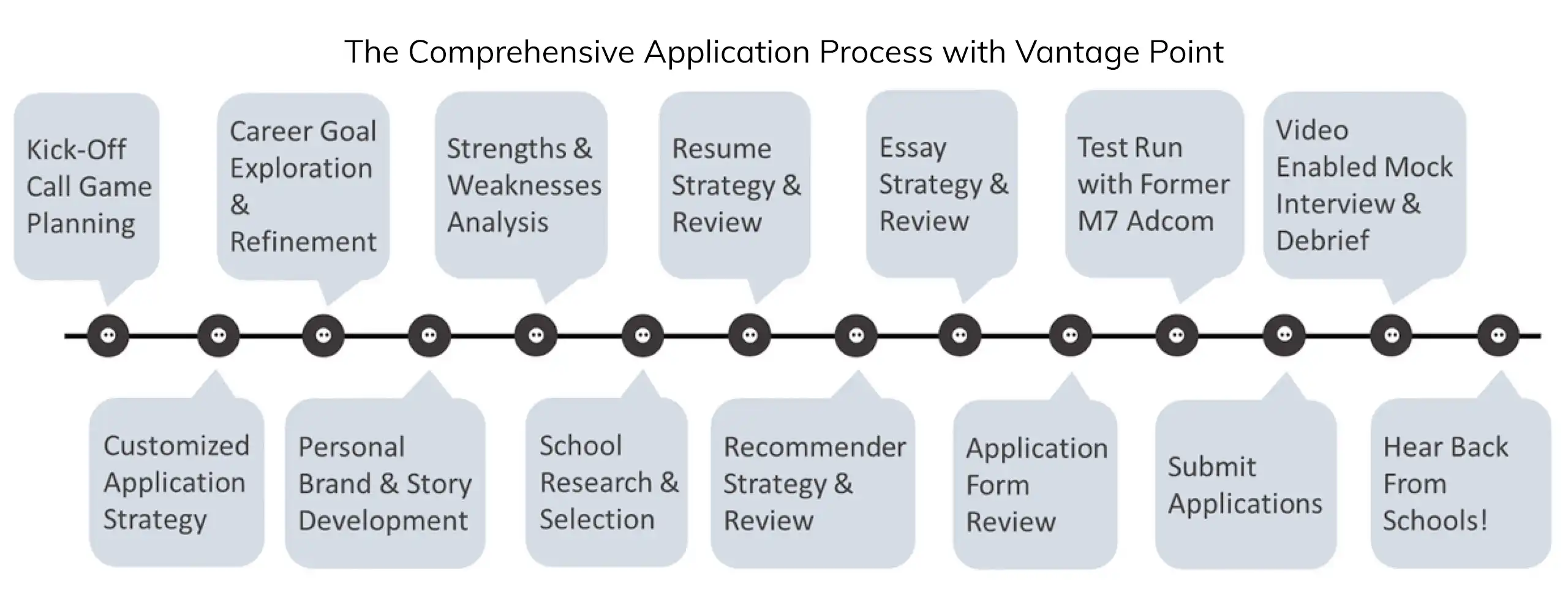Top MBA Program Comparison and How to Use It
Deciding where to apply? Our newly updated Top MBA Program Comparison tool can help! This sortable table ranks the top business schools on dimensions such as class size, average post-MBA salary, top recruited industries and more. It also includes the key criteria (GPA, GMAT, etc.) to help assess where you are likely to be a competitive applicant.
Being thoughtful about school selection is critical and it goes way beyond the rankings. Not only is the degree expensive, but the application process is too (not to mention time consuming). You want to limit your list to a small number of schools that make the most sense for you while maximizing your chances of admission. Furthermore, “fit” plays a huge role in the admissions process. If you don’t make the effort to research which schools are right for you and why, you’ll have a hard time convincing the adcom that their school is the right place for you.
Using the Top MBA Program Comparison Tool
If you are just beginning the school selection process, we recommend using our tool as follows:
Step 1: With your GMAT/GRE score and undergraduate GPA in hand, go down the list and find the programs where your stats meet the average. That will give you a good idea of the range of schools where you’re competitive and where you’re a bit of an outlier.
Other factors such as age, work experience, nationality, etc. will then skew your range up or down slightly. You may need to do some additional research to understand how your work experience compares to past admitted students, for example. Similarly, nationality can work for you or against you, depending on how many applicants from your country apply to your schools. If you’re not sure where you stand, this is a great opportunity to get a profile review by a professional through the forums or with an MBA admissions consultant.
Note: That’s not to say that you shouldn’t apply to your dream school even if you fall outside of its range; but in those cases, it always makes sense to hedge your bets with a couple of target (i.e., “safer”) schools. (No top school is “safe”, but there will be programs where your profile is more competitive than their averages.)
Step 2: Narrow down from there. Once you have an idea of where you’re competitive, identify the schools that are the best fit for your profile and objectives.
Here are some factors to consider in your research:
Class size: this one really boils down to personal preference. Programs like HBS and Wharton, for example, have large class sizes (>850 students) while others like Haas and Tuck have more intimate class sizes (<300 students). The size of your class will play a big role in the type of experience you have during your two years at a top MBA program. It’s important to understand the pros and cons of each and determine which one is better aligned to your objectives. For example, small programs boast tight-knit, congenial communities while larger programs offer greater breadth and diversity in each class.
Recruiting statistics: applying to schools that have a history of placing graduates in your dream job(s) simply makes sense. While all the top schools will have diversified employment statistics, you may see some bias towards consulting, tech, etc. That’s not to say that you should write-off a school simply because your target industry isn’t the #1 recruited industry. It’s simply another factor to consider.
Location: this is one that we encourage you to be flexible with as much as possible. Remember that it’s only for two years and all the top programs have widely influential brands that will in no way limit your career options to a 50-mile radius from campus.
On the other hand, if your post-MBA goals are concentrated in a specific geography (i.e., NYC for finance and fashion, Bay Area for tech, etc.) then it does make sense that programs in those areas would rise to the top of your list. If you have a strong affinity for urban vs. rural locations, don’t ignore it entirely – just don’t let geography be the sole deciding factor.
Next Steps After You Consult the Top MBA Program Comparison Tool
The rest of the process is more art than science. Beyond those shown in our Top MBA Comparison tool, consider factors such as:
Teaching method: this is a big one, particularly if you’re considering HBS or Darden where the case method dominates most of the curriculum. If you’re not sure what the case method is, we strongly suggest reading up on it because it creates a unique classroom dynamic (relies on class participation – students do 85% of the talking in class, involves cold-calling, requires thorough preparation of the case prior to class, etc.) The other teaching methods you’ll find in the top programs are lectures and experiential learning (think immersion classes, team-based exercises, etc.) Pay attention to this and how it differs between schools because it will have a big impact on how you learn for the next two years.
Academic strength or research focus: let’s start by clarifying that all of the top MBA programs offer a general management education with a broad selection of electives across all business subject areas (marketing, finance, operations, entrepreneurship, etc.). In other words, you will have access to fantastic professors and cutting-edge academics in any subject no matter which school you attend. Gone are the days of Wharton being only a “finance” school or Kellogg being only a “marketing” school. With that said, certain programs may offer greater resources or specific programming dedicated to your area of focus. For example, Columbia has the Value Investing program, Wharton has the Health Care Management major, NYU Stern has the Luxury Marketing specialization, etc. Depending on which industry or function you’re targeting after business school, it may make sense to apply to a top MBA program that has a strong legacy in that field, either from the strength of the curriculum, breadth of electives, caliber of the faculty, prominence of research, or otherwise.
Culture: this one is a bit trickier to figure out, especially when you’re just starting the research process. It’s hard to really understand how the schools are different from simply browsing their websites. This is where engaging with the school (visiting campus if possible, attending info sessions, etc.) and speaking with alums and current students really pays off. After a couple different discussions, you’ll start to get a sense for how the programs are different from each other. In terms of which culture is right for you, that’s a matter of personal preference. If you have an independent streak, then maybe Booth is right for you. On the other hand, looking for a supportive, team-oriented environment? Kellogg or Tuck may be right up your alley. Lastly, we’ll say that while certain programs may have “reputations” that you’ve heard of, we recommend doing your own independent homework and deciding if you agree or not (they’re often over-stated, over-simplified, or outdated in our experience).
Bottom Line
After a certain amount of research, you’ll get a “gut” sense of the programs that are right for you on multiple levels. Try to keep an open mind while remaining true to yourself and your goals. Best of luck!
Katie is a passionate mentor and coach, helping her clients craft a unique, compelling story by leveraging her experience as a corporate executive, alumni interviewer, and campus recruiter. Before completing her MBA at Kellogg, Katie spent five years in banking where she learned practical finance skills as well as how to operate in a demanding, high pressure environment. She pursued an MBA in order to transition to an industry role where she could utilize her finance knowledge to drive change within an organization. Post-MBA, she worked in finance and strategy for a leading CPG firm, progressing to an executive role leading the finance function for a $2B business segment. Her experience managing diverse teams led to a passion for developing others. In addition to her day-to-day responsibilities, she led her firm’s MBA recruiting efforts and served as an alumni admissions interviewer for Kellogg.




